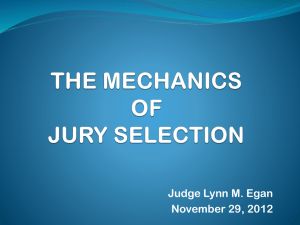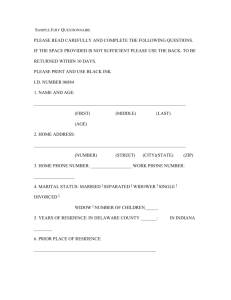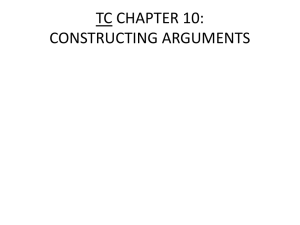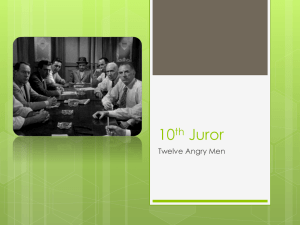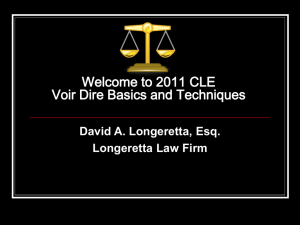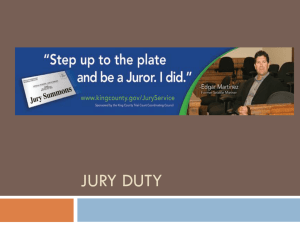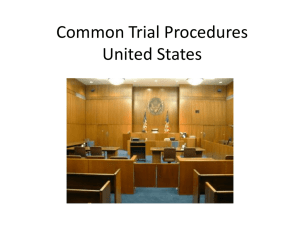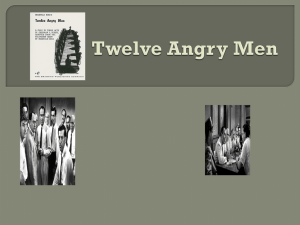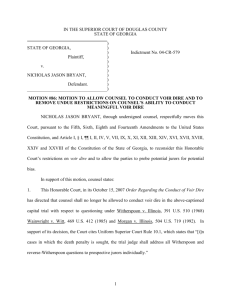Voir Dire: An Intimate Dance
advertisement
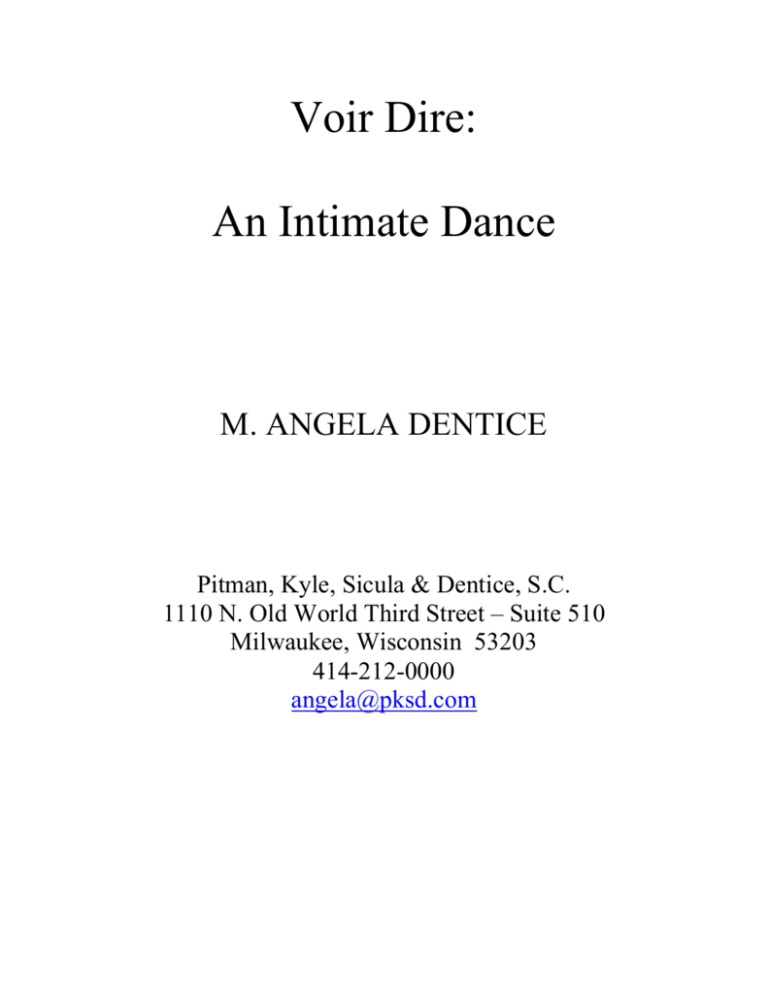
Voir Dire: An Intimate Dance M. ANGELA DENTICE Pitman, Kyle, Sicula & Dentice, S.C. 1110 N. Old World Third Street – Suite 510 Milwaukee, Wisconsin 53203 414-212-0000 angela@pksd.com I. INTRODUCTION “[J]ury selection is the most significant part of any trial because it is during this complex ceremony that we choose who will decide the controversy. Simply defined, it is the process where information is gathered to determine which jurors should be disqualified either peremptorily or for cause. Acknowledged experts in the field believe that 85% of the cases litigated are won or lost when the jury is selected.” Fahringer, “Mirror, Mirror on the Wall …,” 64-Jan N.Y. St. B.J. 22 (1992). II. EXAMINATION OF PROSPECTIVE JURORS A. Court Examination 1. Wisconsin Statute 805.08(1) JURORS’ QUALIFICATIONS, EXAMINATION The court shall examine each juror under oath to discover whether the juror a. Is related by blood or marriage to any party or attorney appearing in the case; b. Has any financial interest in the case; c. Has expressed or formed any opinion; d. Is aware of any bias or prejudice in the case. 2. Voir dire is conducted under the supervision of the court and a great deal of it must be left to the court’s discretion. The trial court’s exercise of discretion in conducting voir dire of jurors will not be disturbed unless it is abused or a rule of law is violated. State v. Moats, 156 Wis. 2d 74, 99, 457 N.W.2d 299 (1990) (citing Ristaino v. Ross, 424 U.S. 589, 594 (1976); Hammill v. State, 89 Wis. 2d 404, 408, 278 N.W.2d 821 (1979)). 3. The trial courts broad discretion is subject to the essential demands of fairness. State v. Koch, 144 Wis. 2d 838, 847 (1988). 4. If the panel of prospective jurors does not adequately represent the community’s racial and ethnic makeup, the trial court may declare a mistrial and try again when the randomly selected panel of prospective jurors offers a more fair representation of the community. Oliver v. Heritage Mut. Ins. Co., 179 Wis. 2d 1, 11, 505 N.W.2d 452 (Wis. Ct. App. 1993). B. Attorney Examination 1. WI. Stat. 805.08(1) a. Does not deny the right to attorneys of either party to supplement the court’s examination as to a juror’s qualifications. b. Such attorney examinations shall not be: i. Repetitious; ii. Based on hypothetical questions. c. During voir dire, the court should ask the general questions covering the basic areas, with the attorneys being allowed to put forth individual questions to jurors covering matters not included in the court’s questions. Filipiak v. Plombon, 15 Wis. 2d 484, 113, N.W.2d 265 (1962). C. Impartiality vs. Juror Bias a. As of 2001, the Supreme Court of Wisconsin has overruled State v. Ramos through State v. Lindell by citing to Wis. Stat § 805.18(2) and explicitly abandoned the doctrine of automatic reversal when an attorney uses a peremptory strike to exclude prospective jurors who should have been removed for cause. State v. Lindell, 245 Wis.2d 689, 74046 (Wis. 2001). b. The Supreme Court of Wisconsin has laid out the current analysis of juror bias claims under Wis. Stat. 805.08 in State v. Lindell. Under this framework, an appellate court will “first determine whether the circuit court erred, using the appropriate standard of review for each type of bias claim. Then, if [the court] determine[s] that a circuit court's decision is clearly erroneous (in the case of subjective bias), or an error of law (with respect to other alleged claims), [the appellate court will] evaluate whether the error has affected the substantial rights of the party. This analysis is conducted in fact situations in which a defendant has not claimed a violation of his or her Sixth Amendment right to an impartial jury.” Id. at 746. c. When analyzing juror impartiality, Lindell has recognized and expounded upon three types of bias as established in State v. Faucher. Id. at 710 (citing State v. Faucher, 227 Wis.2d 700, 716 (1999). i. “Statutory bias” refers to scenarios where a person falls within a statutorily laid out category and is prohibited from serving as a juror regardless of his or her personal ability to be impartial. Id. ii. “Subjective bias” involves “[d]iscerning whether a juror exhibits this type of bias depends upon that juror’s verbal responses to questions at voir dire, as well as that juror’s demeanor in giving those responses.” Id. at 711 (quoting State v. Kiernan, 227 Wis.2d 736, 745 (1999)). iii. “Objective bias” focuses upon whether a reasonable person in the individual prospective juror’s position could be impartial in light of the specific facts and circumstances in the case at hand. This is a question of both fact and law and courts will uphold lower courts factual findings unless they are found to be clearly erroneous. Id. at 712-13 (citing State v. Foucher, 227 Wis.2d 700, 718-19 (1999)). D. Batson / Edmonson Challenges a. The Supreme Court in Batson v. Kentucky held in a criminal case that peremptory challenges may not be based upon race. Batson v. Kentucky, 476 U.S. 79, 89, 106 S. Ct. 1712, 90 L. Ed. 2d 69, 54 (U.S. 1986). i. However, this ruling merely requires that an attorney faced with a Batson challenge demonstrate that a “permissible racially neutral selection criteria and procedure[] have produced the monochromatic result." Id. at 94 (citing Alexander v. Louisiana, 405 U.S. 605, 632). b. Five years after the Batson case the Supreme Court of the United States extended the same “Batson Challenge” protections to civil cases as well. Edmonson v. Leesville Concrete Co., 500 U.S. 614 (U.S. 1991). c. Eight years later in J.E.B. v. Alabama ex rel. T.B. the Supreme Court extended its rule in Batson to exclude the use of peremptory challenges based solely upon gender. 511 U.S. 127, 145 (U.S. 1994). i. While J.E.B. was a criminal case and relied upon Batson, the court explicitly stated that “[w]e [the court] have recognized that whether the trial is criminal or civil, potential jurors, as well as litigants, have an equal protection right to jury selection procedures that are free from statesponsored group stereotypes rooted in, and reflective of, historical prejudice” while citing directly to Edmonson and thus reaffirmed that the scope of equal protection rights in jury selection procedures extend to both criminal and civil cases. J.E.B., 511 U.S. at 128. III. PRACTICAL CONSIDERATIONS A. Purpose or Goal of Voir Dire 1. To locate and be able to strike those panel members whose backgrounds or attitudes make them “champions” for the defense position during deliberations. 2. To discover the attitudes of jurors regarding: the type of liability involved the type of injuries/harms (physical evidence/no physical evidence) psychological/emotional derivative harms or injuries 3. To allow the panel to gain respect for the plaintiff, who is not a “victim” but a proactive survivor of the crash or event. 4. To allow the panel to gain respect for the plaintiff’s lawyer who is genuinely interested in what the panel has to say, is honest, and is knowledgeable. 5. To assist the panel in understanding their important role as jurors. B. During Voir Dire: The conduct of the lawyer is important 1. Show confidence in your case, the evidence, and your client. 2. Show belief that your side is just and true. 3. Demonstrate that you, as the lawyer, are sensitive to the panel’s desire for privacy and will honor those concerns during the voir dire process. 4. Honor the answer, no matter what it is. Thank all panel members for their responses. Continue to state “there are no right or wrong answers.” C. Points to Keep in Mind 1. Primacy: “Primacy” is the tendency to continue to believe that which one first believes . . .Once they believe something it colors how they hear everything that follows . . . So by the end of voir dire and opening, you want jurors to believe that the trial is about harm and damages . . .“ David Ball, David Ball on Damages, 56 (The National Institute for Trial Advovacy, 2d ed. 2005). 2. Persistence: “Persistence” is the mechanism by which primacy works. Persistence is the tendency to process new information in ways that support what we already believe . . .” Id. At 56. 3. You cannot select a jury based on demographics: race, gender, age, nationality, occupation, etc. 4. Don’t try to persuade or inform. Your job is to listen. 5. Ask as many open ended questions as you are allowed. You need to hear the panel speak and you need to see them while they speak. (“Shut up and listen.”) Tell me about that Tell me why Tell me what Tell me how 6. Use different techniques to word questions. a. Lower the barrier “What problems – even small ones – would you have, including money, in your verdict for pain and suffering?” Id. at 290. b. Some people - Some people would never give money for pain and suffering because ….. Other people think money for pain and suffering is fine. Which group do you think you might be closer to, even a little? Id. at 291. 7. Ask questions about your greatest fear or most vulnerable part of your case. Don’t be afraid of poisoning the jury. It is better to know. 8. “You cannot change juror attitudes, beliefs, or opinions. It is damaging even to try.” Id. at 303. 9. Spot the leaders. Remove those that are likely to be unfavorable to your case. Only keep the leaders who are very likely to be favorable to your case. 10. Strikes for Cause: Start with open ended questions and end with leading questions. D. Steps to Prepare for Voir Dire IV. 1. Think about and note all of the “good” points in your case. 2. Think about and note all of the facts/issues that “frighten” you about your case. 3. Think about and note the attitudes/characteristics of a juror who you would like to decide your client’s case. 4. Think about and write down the attitudes/characteristics of a juror who you would not like to decide your client’s case. QUESTIONNAIRES A. Potential Advantages of Jury Questionnaires 1. Shorten the time necessary to complete the voir dire process. 2. Provide privacy to potential jurors to respond to sensitive issues: health history alcohol/drug treatment criminal offenses driving record personal beliefs membership in organizations 3. Prevent potential jurors from hearing the responses of other jurors and from being influenced by the responses of others. 4. Provide counsel with an overall perspective of juror bias in certain areas. jury system personal injury claims size of verdicts personal injury attorneys advertising by attorneys B. Potential Disadvantages of Jury Questionnaires 1. No opportunity to observe the demeanor of potential jurors as questions are asked an answered. 2. Potential jurors may be embarrassed if they do not have adequate reading and writing skills. 3. Counsel may be precluded from questioning further on a topic and/or response if the questioning becomes “repetitious.” (See Wis. Stat. Sec. 805.08(1)) C. Suggested Procedures if All Counsel Agree to Use a Jury Questionnaire 1. Each side drafts a proposed jury questionnaire. 2. The court combines the questions on all drafts and eliminates duplicate questions. 3. The court’s proposed jury questionnaire is submitted to counsel. 4. Counsel make changes in the court’s proposed jury questionnaire. 5. A stipulation is placed on the record to use the final draft of the jury questionnaire. 6. In a jurisdiction in which jury array lists are available before trial, you may get the benefit of completed questionnaires well in advance of trial. D. Suggested Procedure if Counsel Cannot Agree to Submit a Jury Questionnaire 1. Make a request to the court well in advance of trial at pretrial conference formal motion before the court 2. Include with your request or motion a draft of the jury questionnaire. 3. Offer opposing counsel an opportunity to review the questionnaire prior to submitting it to the court and to include additional questions. 4. If the court grants the request or motion and if you are in a jurisdiction which has access to the jury lists days or weeks before trial, ask for the completed questionnaires well in advance of voir dire. E. Authority 1. Wisconsin appellate courts have not addressed the narrow issue of the propriety of jury questionnaires. 2. An example of an appellate decision from another jurisdiction which concluded that there is nothing which prohibits such a practice is State v. Bible, 175 Ariz. 549, 858 P.2d 1152 (1993). i. Facts: Bible, a criminal defendant, was charged with murder and kidnapping. The case generated much pretrial publicity. The trial court submitted to the jury a questionnaire containing thirty pages and fifty-six questions. The questions addressed the following issues: - news media and the perception of news media accuracy law enforcement scientific testing death penalty familiarity with the defendant and the witnesses applicable standard of proof frame of mind if chosen to “sit in judgment” ii. Conclusion: “The questionnaire, the use of which was entirely appropriate in this case, constituted nearly all of the voir dire. The questionnaire not only revealed a great deal of relevant information from a large panel of prospective jurors, but also enabled the trial judge to avoid infecting jurors with answers that necessarily would have been given to the same questions if propounded during oral voir dire.” 858 P.2d at 1173. V. PEREMPTORY STRIKES Issue: If there is more than one defendant, are each of the defendants entitled to three peremptory strikes? A. §805.08(3), Wis. Stat., limits all the defendants, collectively, to three peremptory challenges: Each party shall be entitled to 3 peremptory challenges which shall be exercised alternately, the plaintiff beginning; and when any party declines to challenge in turn, the challenge shall be made by the clerk by lot. The parties to the action shall be deemed 2, all plaintiffs being one party and all defendants being the other party, except that in a case where 2 or more defendants have adverse interests, the court, if satisfied that the due protection of their interest so requires, in its discretion, may allow peremptory challenges to the defendant or defendants on each side of the adverse interests, not to exceed 3. Each side shall be entitled to one peremptory challenge in addition to those otherwise allowed by law if additional jurors are to be selected under sub. (2). B. The only time the court may, in its discretion, permit a defendant to exercise additional peremptory challenges is when the court is satisfied that there is an “adversity of interest” between the defendants. Section 805.08(3), Wis. Stat., does not define “adverse interests.” C. The only Wisconsin case substantively addressing the adversity requirement is Hundhausen v. Adkins, 36 Wis. 518 (1875). In Hundhausen, the court stated that: Undoubtedly, when several defendants in a civil action join in their defense, or, severing in their answers, set out but one defense, common to them all, they constitute one party, limited to the statutory number of challenges given to a party as ruled I this case in the Court below. In such a case, they might and perhaps ought to join in one answer, setting up the common defense; and they should not be permitted to gain additional challenges by the mere act of severing in their pleadings. They have a community of interests, and should be left to a community of challenges. Id. at 520. The court went on to say that it is only when the defenses are “essentially different,” especially when they are “hostile,” and when the “defendants must necessarily sever in their answers; and as each has a distinct issue to maintain . . . that each is to be considered a party.” In Hundhausen, the court concluded that the defendants’ interests were sufficiently adverse when each set up a separate defense for himself, “tending, if the plaintiff should recover, to shift the liability from himself and to fasten it on his codefendant.” Id. at 519. The court noted, however, that absent such adversity, “[i]t was certainly not the intention of the statute to give separate challenges to each defendant in civil cases ….” Id. at 520. D. A commentator evaluating the Wisconsin Rules of Civil Procedure has stated: “Where one defendant cross-claims for damages against another defendant, adversity unquestionably exists.” Patricia Graczyk, The New Rules of Wisconsin Civil Procedure, 50 Marq. L. Rev. 671, 692 (1976). See Klink v. Capelli, 179 Wis. 2d 624, 634, 508 N.W.2d 435 (Ct. App. 1993). E. For opinions from other jurisdictions, see Ellenbecker v. Olin, 71 N.W.2d 208 (S.D. 1955); Schultz v. Gilbert, 20 N.E.2d 884 (Ill. Ct. App. 1939); Hendrickson v. Drewrys, Ltd., 212 N.E.2d 247, 248 (Mass. 1965). F. Even if the court finds adversity between or among defendants, the court has discretion to limit the number of strikes for defendants. The purpose of peremptory strikes is to provide both plaintiffs and defendants with a “fair trial by a panel of impartial jurors.” See Hammill v. State, 89 Wis. 2d 404, 408, 278 N.W.2d 821, 822 (1979). It is within the court’s discretion how to allocate strikes to achieve fairness. See State v. VanStraten, 140 Wis. 2d 306, 409 N.W.2d 448 (Ct. App. 1987).

